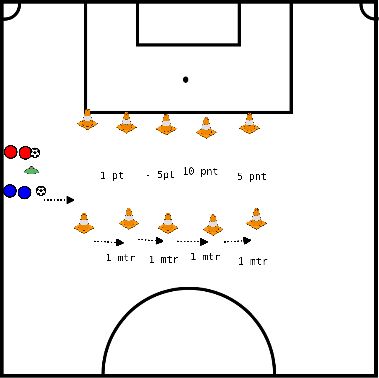Soccer drills
1st exercise:
- Player A plays the ball in to B and runs to B's position.
- Player B stands open turned, takes it and passes it to Player C and so on.
- Point of attention playing in:
- the ball must be hit in the middle so that it stays low.
- The correct technique for this is to lift your shooting leg slightly.
- Passing point:
- The player who accepts the ball should not be facing the ball with his or her body, but turned "open". You create this by positioning your body towards the player you are passing to and with your eyes on the ball.
- Playing around clockwise, the ball is taken on with the left and I play on with the right.
- In the other direction take on with the right and play on with the left.
- If you notice it's too easy, first increase the pace. Then to make it more difficult you can take out the assumption and they have to pass the ball directly.
2nd exercise:
- Player B asks for the ball.
- Player A plays into player B.
- Then B then drops the ball to player A after which he passes it back to player C.
- Player C then drops it to player B and then player B plays it diagonally to player D and so on.
Points of attention:
- The player who plays the ball in must move on after the play-in so that he can ask for the ball, in the middle, between the pawns
- Not further because then the effect is gone with the cross pass.
- The player who rebounds runs around his own pawn to ask for the ball again in the middle.
- This player must make the correct turn when rebounding so that he keeps his eyes on the ball.
- His turn should be short toward the box and not off the play.
In both drills after 8 minutes, change directions of play.
Clockwise passes with right leg, counterclockwise passes with left leg.
Clockwise passes with right leg, counterclockwise passes with left leg.
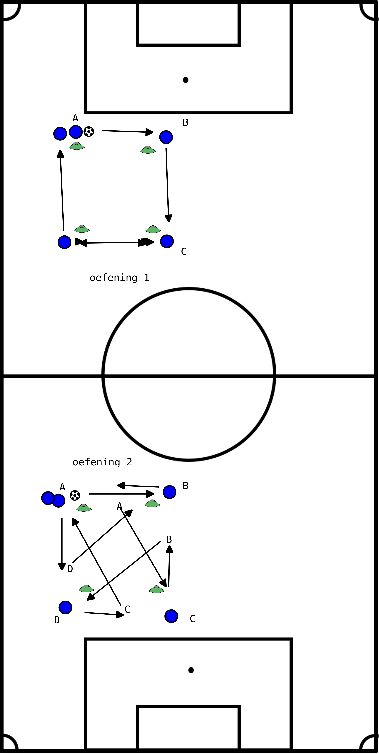
Square with 5 players or triangle with 4 players, at a distance of about 15 meters:
- Player at hat with 2 players starts.
- Plays the ball in on the right side and runs after his ball to the other hat.
- The player receiving the ball turns open and takes the ball well so that he can pass it in to the next player.
- Practice both counterclockwise and clockwise.
3 or 4 players per set:
- Two hats spaced about 15 yards apart.
- 2 players on one side and 1 or 2 players on the other side.
- 1 of the 2 players plays the ball to the other side and continues halfway to the other hat.
- The player on the other side takes the ball and plays it in to the player who ran halfway.
- This player rebounds the ball and continues to the other hat.
- The player who receives the ball back takes the ball and plays it to the player on the side where it was started.
- Running through like this.
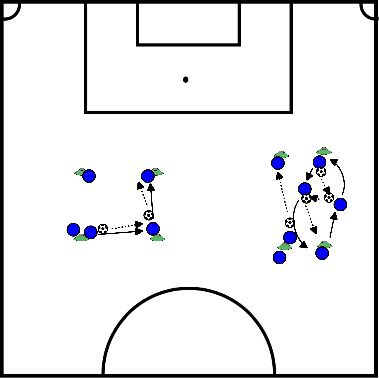
- Core: planking 1 minute
- Side planks half minute both sides
- Abdominals: In pairs:
- 1 lies on back with head between legs other player and holds hands at ankles.
- The one lying down lifts his/her straight legs up and the one standing throws the stretched legs one way.
- The legs must not touch the ground.
- 10 x both players.
- Back: lie on your stomach and lift your arms and legs off the ground for 10 seconds. 10 x repeat.
- Core: planks 1 minute straight and 2x half minutes sideways
- Abdominal muscles: With twosome:
- Both players lie on back and lean on elbows with feet facing each other and feet just overlapping.
- The stretched legs should be off the ground and the feet should do 10 circles around each other counterclockwise and then 10 circles clockwise.
- Back: Superman:
- On hands and knees.
- 1 Arm and opposite leg are held in the air and stretched forward/backward for 10 seconds.
- Then switch for other arm and leg.
- Repeat this 10 times.
- Large rectangle, penalty box.
- Group split into two teams, no competition.
- Teams start at the same time in opposite corners.
- First gentle run, about 40% of maximum, on the long side.
- Diagonal at slightly faster pace, about 60% of maximum.
- At the pawns in the middle keep to the left.
- When you come back to the long side again in gentle run 40% and the diagonal again 60%.
- Keep this up in time.
- As an alternation you can turn half a turn and use the same diagonal on the short side.
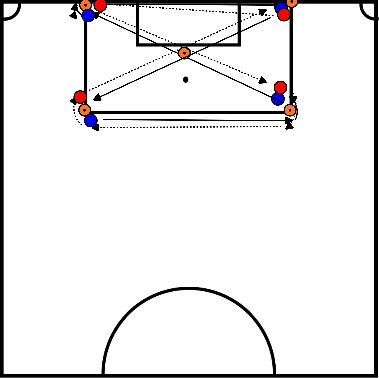
1st exercise:
- Player A plays the ball in to B and runs to B's position.
- Player B is open turned takes it and passes it to Player C and so on.
- Focal point 1 playing in: the ball must be hit in the middle so that it stays low.
- The correct technique for this is to lift your shooting leg slightly.
- Focal point 2 receiving: The player who has to receive the ball should not be facing the ball but rather, as they say, turned open. You create this by positioning your body towards the player you have to pass to and your face is facing the ball. Playing the ball around clockwise, the ball is taken on with the left and I play on with the right. other way round take on with the right and play on with the left.
- If you notice that it is too easy, first increase the tempo. If that also proves too easy then you take out the takeover and they have to pass the ball directly.
2nd exercise:
- Player B asks for the ball, player A plays into player B. Then B drops the ball to player A who then passes it on to player C.
- Player C then drops it to player B and then player B plays it diagonally to player D and so on.
Points of attention:
- The player who plays the ball in must move on after playing in so that he asks for the ball in the middle between the pawns
- Not further because then the cross pass effect is gone.
- The player who bounces the ball back runs around his own pawn to ask for the ball again in the middle.
- It is imperative that this player makes the correct turn when rebounding so that he keeps his eyes on the ball.
- His turn should be short toward the box and not off the play.
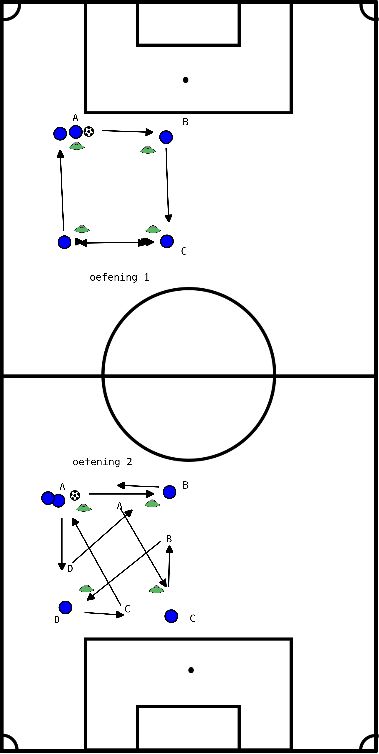
- Split team into two groups.
- Plot field: Two rows with two pawns facing each other at a distance of about 15 meters.
- Each team runs behind each other each time between the two pawns and around the other pawn and back again.
- Jogging 2 laps around half a field or back and forth across the width of the field 4 times
- 3 x 8 times lifting knees backwards, jogging backwards
- 3 x 8 times heels buttocks outward, back jogging
- Outward jog with single arm swing, left 3 to 4 times and then right 3 to 4 times, then left again, etc.
- Back jog with both arms forward, 3 a 4 times, then both arms back 3 a 4 times and repeat
- Sideways jumping jack movement back and forth, changing direction you are facing every 3 passes.
- Cross passes back and forth, every 3 passes changing direction you are facing.
- Walking backwards outward, sideways backward movement 3 steps left, 3 steps right back
- Low tripling out, high tripling with knee lift back
- Lunge passes forward outward, jog backward
- Light tempo acceleration outward to max 60%, and light tempo acceleration back to max 60%
- Everyone together in circle with sufficient distance.
- Arms swing backwards left and right, feet light spread position.
- Arm check and turn back foot in slightly on the front of your foot
- arms turn around making big circles
- up and down left and then right, feet slightly spread out
- mill swings, light spread position, slightly bent knees.
- With your left hand to your right foot, right hand in the air and check, then with your right hand to your left foot and with the left hand in the air and check.
- 10 times left and 10 times right.
- Arms swing backwards left and right, feet light spread position.
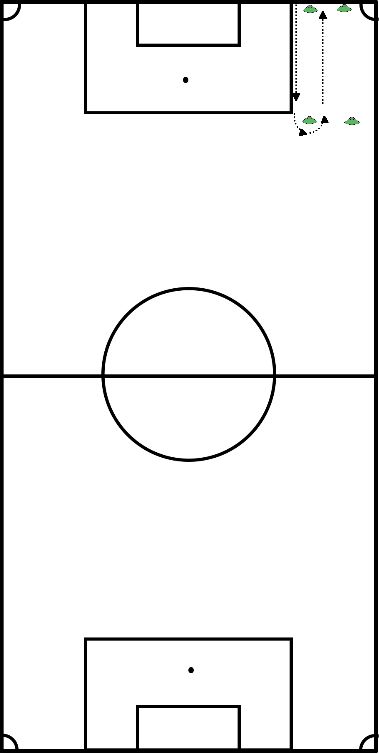
Goal:
Defenders try to intercept the ball quickly:
Exercise:
Defenders try to intercept the ball quickly:
Exercise:
- Play starts at number 6 who kicks to goalkeeper
- Goalkeeper then plays directly to 2 or 4
- At the moment 2 or 4 is played to, the blue team starts pressing and tries to prevent the depth pass
- The red team can "score" by passing a depth pass to number 6, who can move all over the width in his defined zone
- The blue team can score in the big goal
Coaching:
- 2-5 from defending side direct pressure on the ball
- 9 defending directly covers to line the ball
- 4 defending direct pass on number 5 attacking side.
- 6 attackers moving with ball and joining the game
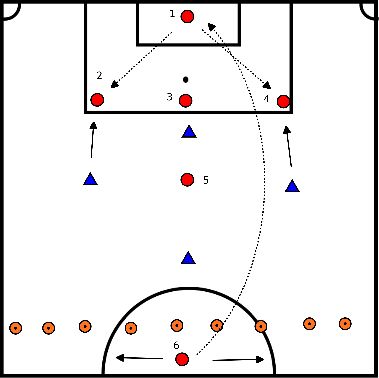
Goal:
Building up from behind in set patterns teach without resistance
Exercise:
Building up from behind in set patterns teach without resistance
Exercise:
- A plays on B
- B passes to A
- A dribbles a little, gives good ball to C
- C dribbles next hat
- C plays on D
- C runs on without ball
- D passes to C
- C works off
Changeover:
- A-B
- B-C
- C-D
- D retrieves ball - becomes A
Coaching:
- Movement without ball
- Good leg and tight passing
- Coach each other by calling out name
Playing style:
- 1-4-4-2
- A= 3-4
- B=6
- C=5
- D=9
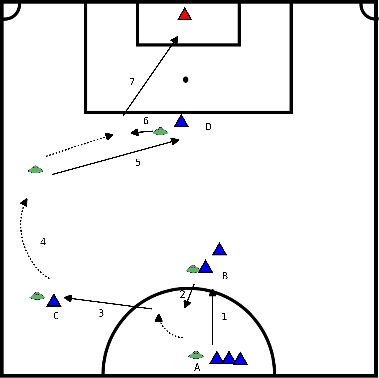
First walk slowly for 3 to 5 minutes to allow your body to switch from a resting to sport mode
Distance 15 meters:
- Heels, buttocks
- Lift the knee
- Connecting step 3 times per side
- Cross step right
- Cross pass left
- Step with knees
- Cross-step/arms
- Groin in
- Groin out
- Swing the leg straight up
- Swing the leg in at an angle
- Quick footwork, tripping
Finish with a short sprint over 30 meters.
- All balls are next to the goal with the trainer.
- The trainer plays the balls to the players.
- The goal is to score. The player who scores stays in the game, while the player who misses or the goalie who stops the ball is out of the game.
- The team with 1 or more players remaining last wins.
- The player who has been goalkeeping makes sure the balls are returned to the coach until players are finished. After that, those players take over.
In groups A through D, players must shoot the ball in front of the 16-yard line. Beyond is off. For groups E through J, the line is halfway between the 5-meter area and the 16-meter line.
- One group starts with goalkeeping, in this case red.
- The trainer plays the ball in and the player from blue runs in and shoots directly at the goal. Don't assume first, then you're off.
- If he hits, he goes goalie and rejoins his group. If he misses, he goes to goal and then collects balls.
- When a player has shot at goal, hit or miss, the next ball from the opponent goes to goalkeeper.
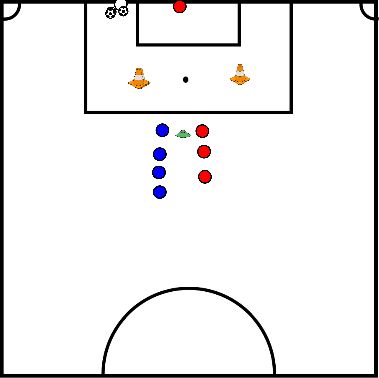
Goal:
Players recognize midfield situation
Exercise:
Players recognize midfield situation
Exercise:
- 1 attacking team blue
- 1 defending team red
- 6 attackers play against 5 defenders
- Attackers play the ball around
- If defenders conquer the ball, they play the ball around
- If the defending team gets the ball to the middle player, the attacking team pressures them
Coaching:
- Letting ball go to the sides
- Ball line shield middle player
- When the middle player does get the ball, pressure immediately
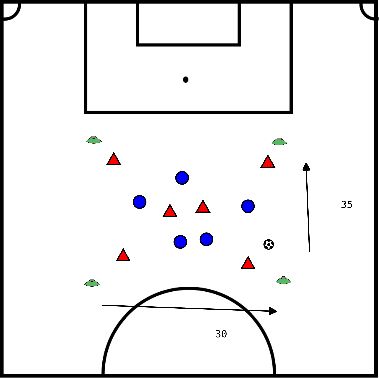
Goal of the exercise is to:
- Pass the ball into the boxes
- Score as many points as possible
- The opposing team's ball may be moved to another box by passing against it with the ball.
- In the youngest groups the distance from the green pawn to the scoring boxes is 5 meters, in the oldest groups it is 8 meters.
- The scoring boxes are 1 meter long and 3 meters wide.
